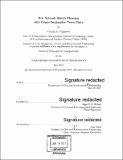Bus network sketch planning with origin-destination travel data
Author(s)
Viggiano, Cecilia A. (Cecilia Ann)
DownloadFull printable version (24.25Mb)
Other Contributors
Massachusetts Institute of Technology. Department of Civil and Environmental Engineering.
Advisor
Nigel H.M. Wilson.
Terms of use
Metadata
Show full item recordAbstract
Public transport plays an important role in urban mobility. Public transport planners seek to improve existing public transport networks to better serve existing passengers and recruit new passengers, particularly as demand patterns change with evolving demographics and land use. One strategy for network improvement is to add new routes, which can improve service by reducing circuity in the network. In large, complex, and multi-modal public transport networks, it is challenging to determine where new routes should be added. A systematic approach for incremental network improvements, such as adding new bus services, is needed. This research proposes a new approach to network-level public transport planning by combining origin-destination (OD) level analysis with new spatial aggregation methodologies, and develops a comprehensive framework for the identification of corridors for new bus services. In the context of this framework, this dissertation contributes several new methodologies. First, it proposes a methodology for defining zones that reflect the spatial characteristics of a public transport network. This produces zonal pairs that are appropriate for OD level analysis of travel in the network. Second, the dissertation develops metrics and rules for the identification of OD pairs that can benefit from new bus services, and proposes methods for estimating the expected benefits of such services at the OD level. Finally, a new methodology for spatially clustering OD pairs into corridors is developed, based on trajectory clustering methods. This final methodology represents a new way of aggregating OD level information to accomplish the first step in bus network design: the definition of corridors for new services. The framework is demonstrated for the identification of corridors for new bus services in the London public transport network. Bus stops and rail stations are clustered into 1,000 zones. A subset of zonal OD pairs with circuitous service are identified as candidates for improvement through new bus routes. An algorithm that clusters OD pairs into corridors for bus service is developed and applied. Several promising corridors are identified, and their potential is confirmed in post-analysis.
Description
Thesis: Ph. D. in Transportation, Massachusetts Institute of Technology, Department of Civil and Environmental Engineering, 2017. Cataloged from PDF version of thesis. Includes bibliographical references (pages 141-147).
Date issued
2017Department
Massachusetts Institute of Technology. Department of Civil and Environmental EngineeringPublisher
Massachusetts Institute of Technology
Keywords
Civil and Environmental Engineering.